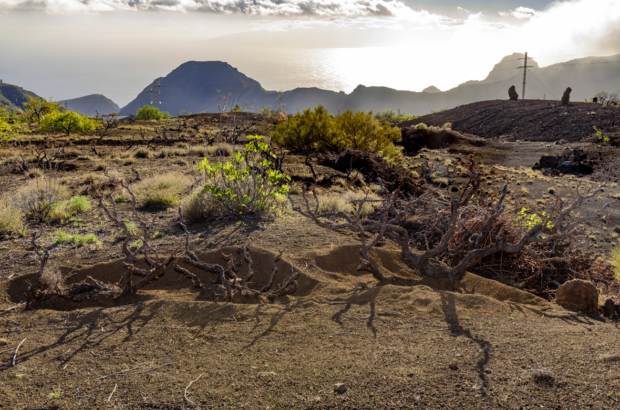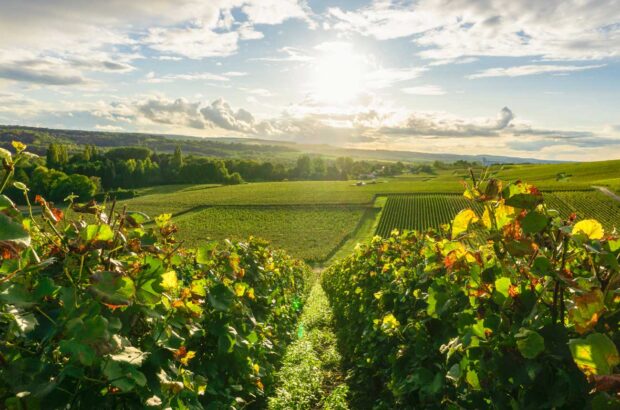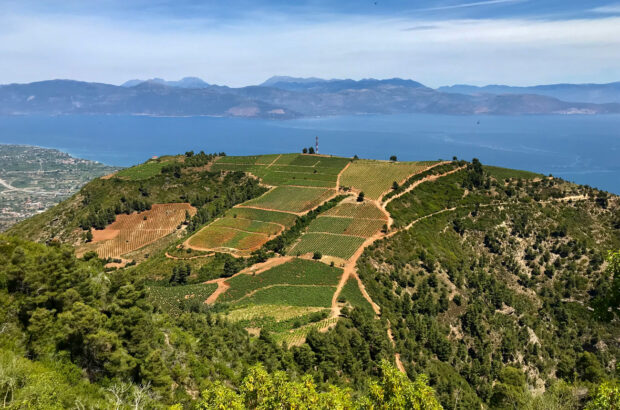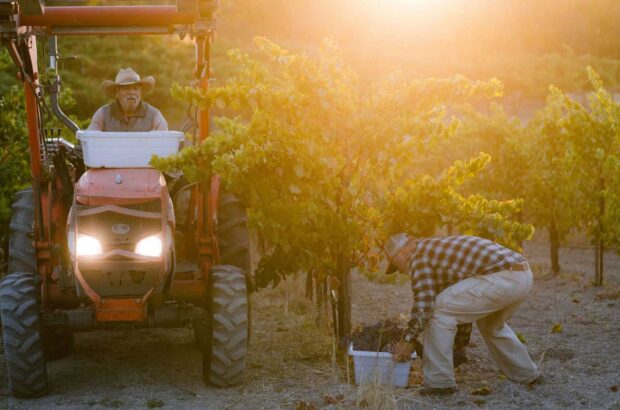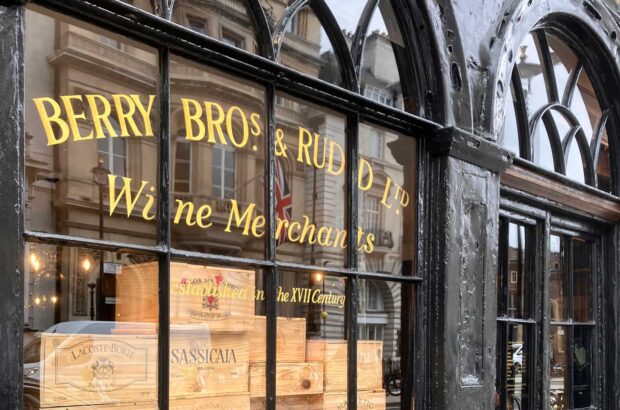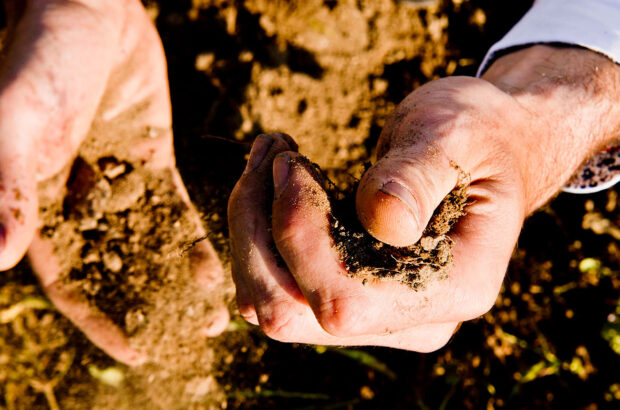St-Julien probably has the strongest identity of any of the major Médoc communes as it’s the most compact, and the smallest. It has much in common with part of Pauillac, just to the north, but its wines tend to be more virile than most from Margaux to the south. Moreover, it is separated from Margaux by a broad strip of Haut-Médoc vineyards. The St-Julien appellation is restricted to red wines only, but two estates – Talbot and Lagrange – have long had a good reputation for their white wine as well.
{"content":"PHA+SXTigJlzIGhhcmQgdG8gYmVhdCBTdC1KdWxpZW4gZm9yIHNoZWVyIGNvbnNpc3RlbmN5LiBFdmVuIGluIFBhdWlsbGFjIHRoZXJlIGhhdmUgYWx3YXlzIGJlZW4gZXN0YXRlcyB3aGVyZSBxdWFsaXR5IGhhcyB0cmFpbGVkIGJlaGluZCB0aGF0IG9mIHNvbWUgb2YgdGhlaXIgbmVpZ2hib3Vycy4gVGhhdOKAmXMgaGFyZGx5IHN1cnByaXNpbmcsIHNpbmNlIFBhdWlsbGFjIGlzIGhvbWUgdG8gdGhyZWUgZmlyc3QgZ3Jvd3RocyB0aGF0IHNldCB0aGUgaGlnaGVzdCBpbWFnaW5hYmxlIHN0YW5kYXJkcy4gU3QtSnVsaWVuIGhhcyAxMSBjbGFzc2VkIGdyb3d0aHMgYnV0IG5vIGZpcnN0IGdyb3d0aHMsIHdoaWNoIG1lYW5zIHRoZXJlIGlzIG5vIHNpbmdsZSBkb21haW5lIHRoYXQgZG9taW5hdGVzLiBTaW5jZSA5NSUgb2YgdGhlIHZpbmV5YXJkcyBoZXJlIGFyZSBjbGFzc2lmaWVkLCB0aGVyZSBpcyBhIHN0cm9uZyBpbmNlbnRpdmUgZm9yIHRoZWlyIHByb3ByaWV0b3JzIHRvIG1haW50YWluIHN0YW5kYXJkcy4gQW5kIHRoZSBmZXcgc3Vydml2aW5nIG5vbi1jbGFzc2lmaWVkIGdyb3d0aHMsIHN1Y2ggYXMgQ2jDonRlYXUgZHUgR2xhbmEgYW5kIENow6J0ZWF1IEdsb3JpYSwgYXJlIGhhcmRseSBzbG91Y2hlcy48L3A+CjxwPjxkaXYgY2xhc3M9ImFkLWNvbnRhaW5lciBhZC1jb250YWluZXItLW1vYmlsZSI+PGRpdiBpZD0icG9zdC1pbmxpbmUtMSIgY2xhc3M9ImlwYy1hZHZlcnQiPjwvZGl2PjwvZGl2PjwvcD4KPGRpdiBjbGFzcz0iYnJlYWtvdXQgcGFsZXR0ZS1hIHBhbmVsIHBhbmVsLWRlZmF1bHQiPjxkaXYgY2xhc3M9InBhbmVsLWJvZHkiPjxkaXYgY2xhc3M9J2JyZWFrb3V0LWNvbnRlbnQnPjwvcD4KPGgzIHN0eWxlPSJ0ZXh0LWFsaWduOiBsZWZ0Ij48c3Ryb25nPlN0LUp1bGllbiBhdCBhIGdsYW5jZTwvc3Ryb25nPjwvaDM+CjxwIHN0eWxlPSJ0ZXh0LWFsaWduOiBsZWZ0Ij48c3Ryb25nPkFQIGNyZWF0ZWQ8L3N0cm9uZz4gMTkzNjwvcD4KPHAgc3R5bGU9InRleHQtYWxpZ246IGxlZnQiPjxzdHJvbmc+UGxhbnRlZCBhcmVhPC9zdHJvbmc+IDkxMGhhPC9wPgo8ZGl2IGNsYXNzPSJhZC1jb250YWluZXIgYWQtY29udGFpbmVyLS1tb2JpbGUiPgo8ZGl2IGlkPSJwb3N0LWlubGluZS0yIiBjbGFzcz0iaXBjLWFkdmVydCI+PC9kaXY+CjwvZGl2Pgo8cCBzdHlsZT0idGV4dC1hbGlnbjogbGVmdCI+PHN0cm9uZz5EaW1lbnNpb25zPC9zdHJvbmc+IDUuNWttIG5vcnRoLXNvdXRoLCAzLjVrbSBlYXN0LXdlc3Q8L3A+CjxwIHN0eWxlPSJ0ZXh0LWFsaWduOiBsZWZ0Ij48c3Ryb25nPkdyYXBlIHZhcmlldGllczwvc3Ryb25nPiBDYWJlcm5ldCBTYXV2aWdub24sIE1lcmxvdCwgQ2FiZXJuZXQgRnJhbmMsIFBldGl0IFZlcmRvdCwgTWFsYmVjLCBTYXV2aWdub24gQmxhbmMsIFNlbWlsbG9uPC9wPgo8cCBzdHlsZT0idGV4dC1hbGlnbjogbGVmdCI+PHN0cm9uZz5Cb3R0bGVzIHByb2R1Y2VkPC9zdHJvbmc+IEFib3V0IDUuNW0gcGVyIHllYXI8L3A+CjxkaXYgY2xhc3M9ImFkLWNvbnRhaW5lciBhZC1jb250YWluZXItLW1vYmlsZSI+CjxkaXYgaWQ9InBvc3QtaW5saW5lLTMiIGNsYXNzPSJpcGMtYWR2ZXJ0Ij48L2Rpdj4KPC9kaXY+CjxwIHN0eWxlPSJ0ZXh0LWFsaWduOiBsZWZ0Ij48c3Ryb25nPkNsYXNzZWQgZ3Jvd3Roczwvc3Ryb25nPiBGaXZlIHNlY29uZHMsIHR3byB0aGlyZHMsIGZvdXIgZm91cnRoczwvcD4KPC9kaXY+PGRpdiBjbGFzcz0nYnJlYWtvdXQtYnV0dG9ucyc+PGRpdiBjbGFzcz0ncm93Jz48L2Rpdj48L2Rpdj48L2Rpdj48L2Rpdj4KPGgzPjxzdHJvbmc+TG9jYXRpb24gbWF0dGVyczwvc3Ryb25nPjwvaDM+CjxwPkFzIGluIG90aGVyIGNvbW11bmVzLCBtYW55IG9mIHRoZSBmaW5lc3Qgd2luZXMgY29tZSBmcm9tIGVzdGF0ZXMgaW4gY2xvc2UgcHJveGltaXR5IHRvIHRoZSBlc3R1YXJ5OiB0aGVzZSBpbmNsdWRlIEJleWNoZXZlbGxlLCBEdWNydS1CZWF1Y2FpbGxvdSBhbmQgdGhlIHRocmVlIEzDqW92aWxsZSBwcm9wZXJ0aWVzLjwvcD4KPGRpdiBjbGFzcz0iYWQtY29udGFpbmVyIGFkLWNvbnRhaW5lci0tbW9iaWxlIj48ZGl2IGlkPSJwb3N0LWlubGluZS00IiBjbGFzcz0iaXBjLWFkdmVydCI+PC9kaXY+PC9kaXY+CjxwPkFzIHdlbGwgYXMgdGhhdCBjbG9zZW5lc3MgdG8gdGVtcGVyYXR1cmUtbW9kZXJhdGluZywgZmxvd2luZyB3YXRlciwgYW5kIHRodXMgYSBkaW1pbmlzaGVkIHJpc2sgb2YgZnJvc3QsIHRoZXkgYXJlIHBsYW50ZWQgb24gZGVlcCBwbGF0ZWF1eCBvZiBHw7xuemlhbiBncmF2ZWwgcmljaCBpbiBxdWFydHosIGNsYXkgYW5kIGZsaW50LiBCb3RoIHRoZSBzb2lscyB0aGVtc2VsdmVzIGFuZCB0aGUgcHJlc2VuY2Ugb2Ygc21hbGwgc3RyZWFtcyAoPGVtPmphbGxlczwvZW0+KSBhcm91bmQgdGhlc2UgcGxhdGVhdXggcHJvdmlkZSBleGNlbGxlbnQgZHJhaW5hZ2UuIEluIGFkZGl0aW9uLCB0aGUgZ3JhdmVsIGNhbiBzdG9yZSBoZWF0IHdoaWNoIGlzIHRoZW4gcmVmbGVjdGVkIG9uIHRvIHRoZSB2aW5lcyBhZnRlciBzdW5zZXQsIGEgcHJvY2VzcyB0aGF0IGVuY291cmFnZXMgc3BlZWRpZXIgbWF0dXJhdGlvbi48L3A+CjxwPkluIGNvbnRyYXN0LCBvdGhlciBlc3RhdGVzIGxpZSBmdXJ0aGVyIHdlc3Qgb2YgdGhlIGVzdHVhcnksIGluY2x1ZGluZyBHcnVhdWQtTGFyb3NlLCBMYWdyYW5nZSBhbmQgVGFsYm90LiBJZiBzbGlnaHRseSBsZXNzIGJsZXNzZWQgYnkgbmF0dXJlIHRoYW4gdGhlIHJpdmVyc2lkZSBwcm9wZXJ0aWVzLCB0aGV5IG5vbmV0aGVsZXNzIHByb2R1Y2UgcmljaCBhbmQgbG9uZy1saXZlZCB3aW5lcy4gUGhpbGlwcGUgRGhhbGx1aW4sIG5vdyB0aGUgZGlyZWN0b3Igb2YgdGhlIE1vdXRvbiBSb3Roc2NoaWxkIGdyb3VwLCB1c2VkIHRvIHJ1biBDaMOidGVhdSBCcmFuYWlyZS1EdWNydSwgd2hlcmUgdGhlIHZpbmV5YXJkcyBhcmUgZGlzcGVyc2VkLCBhbmQgaGUgYmVsaWV2ZXMgdGhlIGtleSB0byB0aGUgcXVhbGl0eSBvZiBTdC1KdWxpZW4gd2luZXMgaXMgdGhlIHByZWNvY2l0eSBvZiB0aGUgZ3Jvd2luZyBzZWFzb24sIG9ic2VydmluZyB0aGF0IGp1c3QgdG8gdGhlIHNvdXRoIGluIEN1c3NhYyAoSGF1dC1Nw6lkb2MpLCB0aGUgaGFydmVzdCBpcyBnZW5lcmFsbHkgYSB3ZWVrIGxhdGVyLjwvcD4KPGRpdiBjbGFzcz0iYWQtY29udGFpbmVyIGFkLWNvbnRhaW5lci0tbW9iaWxlIj48ZGl2IGlkPSJwb3N0LWlubGluZS01IiBjbGFzcz0iaXBjLWFkdmVydCI+PC9kaXY+PC9kaXY+CjxwPlZpbnRhZ2UgY2hhcmFjdGVycyBkb27igJl0IGRpZmZlciBzaWduaWZpY2FudGx5IGZyb20gdGhlIHJlc3Qgb2YgdGhlIHNvdXRoZXJuIE3DqWRvYy4gMjAxMCwgMjAxNSBhbmQgMjAxNiBhcmUgYWxsIGdyZWF0IHllYXJzLCBhbmQgdGhlIHNhbWUgaXMgbGlrZWx5IHRvIGJlIHRydWUgb2YgdGhlIDIwMThzIGFuZCAyMDE5cy4gQm90aCAyMDEyIGFuZCAyMDE3IHdpbGwgYmUgcmVsYXRpdmVseSBmb3J3YXJkLCBhbHRob3VnaCBTdC1KdWxpZW4gZXNjYXBlZCB0aGUgd29yc3Qgb2YgdGhlIGZyb3N0IGluIDIwMTcgdGhhdCByZWR1Y2VkIHlpZWxkcyBzZXZlcmVseSBlbHNld2hlcmUuIDIwMTQgd2FzbuKAmXQgYW4gZWFzeSB2aW50YWdlIGVpdGhlciwgYnV0IHRoZXJlIGFyZSBtYW55IGV4Y2VsbGVudCB3aW5lcy4gSW4gY29udHJhc3QsIDIwMTMgc2hvdWxkIGluIG1vc3QgY2FzZXMgYmUgYXZvaWRlZDogcmFpbiBhbmQgcm90IGltcGFjdGVkIG9uIGJvdGggeWllbGRzIGFuZCBxdWFsaXR5LiBXaGVuIHlvdW5nLCB0aGUgMjAxMXMgd2VyZSByYXRoZXIgc2V2ZXJlLCBidXQgc29tZSBhcmUgbm93IG9wZW5pbmcgdXAsIGFsdGhvdWdoIGl0IHJlbWFpbnMgYSByYXRoZXIgY2hhcm1sZXNzIHllYXIuPC9wPgo8cD5BbHRob3VnaCB0aGVyZSBpcyBhZG1pcmFibGUgY29uc2lzdGVuY3kgdG8gdGhlIHdpbmVzLCB0aGV5IGFyZSBmYXIgZnJvbSB1bmlmb3JtIGluIHRoZWlyIHR5cGljaXR5LiBUaGV5IGFyZSBsZXNzIGZpbGlncmVlIGFuZCBwb2lzZWQgdGhhbiB0aGUgYmVzdCBNYXJnYXV4LCB5ZXQgbGVzcyB3ZWlnaHR5IGFuZCBtdXNjdWxhciB0aGFuIHRoZSBtb3N0IGNlbGVicmF0ZWQgUGF1aWxsYWNzLiBCdXQgc3VjaCBnZW5lcmFsaXNhdGlvbnMgY2FuIGJlIG1pc2xlYWRpbmcuIFN0eWxpc3RpY2FsbHksIGV2ZW4gZmlyc3QgZ3Jvd3RocyBpbiBQYXVpbGxhYyBjYW4gZGlmZmVyIGdyZWF0bHksIGFzIGEgY29tcGFyaXNvbiBiZXR3ZWVuIExhdG91ciBhbmQgaXRzIG5laWdoYm91ciBMYWZpdGUgZGVtb25zdHJhdGVzLiBBIHdlbGwta25vd24gQm9yZGVhdXggYnJva2VyIGNvbmNsdWRlZCBpbiAxODE1IHRoYXQgU3QtSnVsaWVuIHdpbmVzIHdlcmUg4oCYbW9yZSBzbW9vdGggYW5kIG1lbGxvd+KAmSB0aGFuIHRob3NlIGZyb20gb3RoZXIgY29tbXVuZXMuPC9wPgo8ZGl2IGlkPSJhdHRhY2htZW50XzQzOTM4OCIgc3R5bGU9IndpZHRoOiAxMzEwcHgiIGNsYXNzPSJ3cC1jYXB0aW9uIGFsaWdubm9uZSI+PGltZyBmZXRjaHByaW9yaXR5PSJoaWdoIiBkZWNvZGluZz0iYXN5bmMiIGFyaWEtZGVzY3JpYmVkYnk9ImNhcHRpb24tYXR0YWNobWVudC00MzkzODgiIGNsYXNzPSJsYXp5bG9hZCBibHVyLXVwIHNpemUtZnVsbCB3cC1pbWFnZS00MzkzODgiIGRhdGEtcHJvY2Vzc2VkIHNyYz0iaHR0cHM6Ly93d3cuZGVjYW50ZXIuY29tL3dwLWNvbnRlbnQvdGhlbWVzL3NpbWJhLXRoZW1lL2Fzc2V0cy9pbWFnZXMvcGxhY2Vob2xkZXIucG5nIiBkYXRhLXNyYz0iaHR0cHM6Ly9rZXlhc3NldHMudGltZWluY3VrLm5ldC9pbnNwaXJld3AvbGl2ZS93cC1jb250ZW50L3VwbG9hZHMvc2l0ZXMvMzQvMjAyMC8wNi9DaGF0ZWF1LUJleWNoZXZlbGxlLmpwZyIgYWx0PSJDaGF0ZWF1IEJleWNoZXZlbGxlIiB3aWR0aD0iMTMwMCIgaGVpZ2h0PSI4NjAiIGRhdGEtc2l6ZXM9ImF1dG8iIGRhdGEtc3Jjc2V0PSJodHRwczovL2tleWFzc2V0cy50aW1laW5jdWsubmV0L2luc3BpcmV3cC9saXZlL3dwLWNvbnRlbnQvdXBsb2Fkcy9zaXRlcy8zNC8yMDIwLzA2L0NoYXRlYXUtQmV5Y2hldmVsbGUuanBnIDEzMDB3LCBodHRwczovL2tleWFzc2V0cy50aW1laW5jdWsubmV0L2luc3BpcmV3cC9saXZlL3dwLWNvbnRlbnQvdXBsb2Fkcy9zaXRlcy8zNC8yMDIwLzA2L0NoYXRlYXUtQmV5Y2hldmVsbGUtMzAweDE5OC5qcGcgMzAwdywgaHR0cHM6Ly9rZXlhc3NldHMudGltZWluY3VrLm5ldC9pbnNwaXJld3AvbGl2ZS93cC1jb250ZW50L3VwbG9hZHMvc2l0ZXMvMzQvMjAyMC8wNi9DaGF0ZWF1LUJleWNoZXZlbGxlLTYzMHg0MTcuanBnIDYzMHcsIGh0dHBzOi8va2V5YXNzZXRzLnRpbWVpbmN1ay5uZXQvaW5zcGlyZXdwL2xpdmUvd3AtY29udGVudC91cGxvYWRzL3NpdGVzLzM0LzIwMjAvMDYvQ2hhdGVhdS1CZXljaGV2ZWxsZS0xMzV4ODkuanBnIDEzNXcsIGh0dHBzOi8va2V5YXNzZXRzLnRpbWVpbmN1ay5uZXQvaW5zcGlyZXdwL2xpdmUvd3AtY29udGVudC91cGxvYWRzL3NpdGVzLzM0LzIwMjAvMDYvQ2hhdGVhdS1CZXljaGV2ZWxsZS0zMjB4MjEyLmpwZyAzMjB3LCBodHRwczovL2tleWFzc2V0cy50aW1laW5jdWsubmV0L2luc3BpcmV3cC9saXZlL3dwLWNvbnRlbnQvdXBsb2Fkcy9zaXRlcy8zNC8yMDIwLzA2L0NoYXRlYXUtQmV5Y2hldmVsbGUtNjIweDQxMC5qcGcgNjIwdywgaHR0cHM6Ly9rZXlhc3NldHMudGltZWluY3VrLm5ldC9pbnNwaXJld3AvbGl2ZS93cC1jb250ZW50L3VwbG9hZHMvc2l0ZXMvMzQvMjAyMC8wNi9DaGF0ZWF1LUJleWNoZXZlbGxlLTkyMHg2MDkuanBnIDkyMHcsIGh0dHBzOi8va2V5YXNzZXRzLnRpbWVpbmN1ay5uZXQvaW5zcGlyZXdwL2xpdmUvd3AtY29udGVudC91cGxvYWRzL3NpdGVzLzM0LzIwMjAvMDYvQ2hhdGVhdS1CZXljaGV2ZWxsZS0xMjIweDgwNy5qcGcgMTIyMHciIHNpemVzPSIobWF4LXdpZHRoOiAxMzAwcHgpIDEwMHZ3LCAxMzAwcHgiIC8+PHAgaWQ9ImNhcHRpb24tYXR0YWNobWVudC00MzkzODgiIGNsYXNzPSJ3cC1jYXB0aW9uLXRleHQiPkNow6J0ZWF1IEJleWNoZXZlbGxlLiBDcmVkaXQ6IFAuIEZhdWNvdW5lYXU8L3A+PC9kaXY+CjxoMz48c3Ryb25nPkh1bWFuIHRvdWNoPC9zdHJvbmc+PC9oMz4KPHA+VGhlIG1vc3QgZmFtb3VzIHZpZXcgaW4gU3QtSnVsaWVuIGlzIHRoZSBncmVhdCBnYXRld2F5IGludG8gdGhlIExhcyBDYXNlcyBoaXN0b3JpYyB2aW5leWFyZHMgYXMgeW91IGRyaXZlIG5vcnRoIHRvd2FyZHMgUGF1aWxsYWMuIElmIHlvdSBzdG9wIHlvdXIgY2FyIChvciBiaWtlKSwgeW914oCZbGwgc29vbiBzZWUgdGhhdCB0aGUgZ3JhdmVsbHkgc3dlZXAgb2YgdGhlIExhcyBDYXNlcyB2aW5leWFyZCBoYXJkbHkgZGlmZmVycyBmcm9tIHRoYXQgb2YgTGF0b3VyIGp1c3QgdG8gdGhlIG5vcnRoLiBJbmRlZWQsIEkgZG91YnQgdGhhdCBpbiBhIGJsaW5kIHRhc3RpbmcgZXZlbiBleHBlcmllbmNlZCB3aW5lIGxvdmVycyB3b3VsZCBuZWNlc3NhcmlseSBwbGFjZSBMYXMgQ2FzZXMgaW4gU3QtSnVsaWVuIHJhdGhlciB0aGFuIFBhdWlsbGFjOyB2b3RlcyB3b3VsZCBiZSBjYXN0IGZvciBlaXRoZXIgb3B0aW9uLjwvcD4KPHA+SXTigJlzIG5vdCBqdXN0IHRoZSB0ZXJyb2lyLCBvZiBjb3Vyc2UuIEl0IG5ldmVyIGlzLiBUaGUgaHVtYW4gaGFuZCBwbGF5cyBpdHMgcGFydCB0b28uIFRoZSB0aHJlZSBMw6lvdmlsbGUgZXN0YXRlcyDigJMgb25jZSBhIHNpbmdsZSBwcm9wZXJ0eSwgbG9uZyBzaW5jZSBkaXZpZGVkIHVwIOKAkyBhcmUgYW4gZXhjZWxsZW50IGNhc2UgaW4gcG9pbnQuIFRoZSBEZWxvbiBmYW1pbHkgb2YgTMOpb3ZpbGxlIExhcyBDYXNlcyBoYXMgYWx3YXlzIGZhdm91cmVkIGEgcmljaCwgZXZlbiBleHRyYWN0ZWQgc3R5bGU6IHBvd2VyZnVsIGFuZCBzdHJ1Y3R1cmVkLCBzbG93IHRvIG1hdHVyZSBhbmQgdmVyeSBsb25nLWxpdmVkLiBUaGUgZnJ1aXTigJlzIHdlaWdodCBhbmQgaW50ZW5zaXR5IGFsbG93IHRoZSB3aW5lIHRvIHN1cnZpdmUgdGhhdCBleHRyYWN0aW9uIGFuZCB0aGUgaGlnaCBwcm9wb3J0aW9uIG9mIG5ldyBvYWsuPC9wPgo8cD5UaGUgQ3V2ZWxpZXIgZmFtaWx5LCBvd25lcnMgb2YgTMOpb3ZpbGxlIFBveWZlcnLDqSBmb3IgYSBjZW50dXJ5LCBoYXMgd29ya2VkIHdpdGggTWljaGVsIFJvbGxhbmQgYXMgaXRzIGNvbnN1bHRhbnQgc2luY2UgMTk5NC4gQXMgaXMgd2VsbCBrbm93biwgUm9sbGFuZCBmYXZvdXJzIGxhdGUgaGFydmVzdGluZyBhbmQgYSBnb29kIGRvc2Ugb2YgbmV3IG9hay4gVGhlIGFpbSBpcyBhbiBvdmVydGx5IG9wdWxlbnQgYW5kIGZsZXNoeSBzdHlsZSB0aGF0IGlzIGltbWVuc2VseSBzYXRpc2Z5aW5nLCBhbHRob3VnaCBzb21lIHdpbGwgcHJlZmVyIHRoZSBtb3JlIHJlc3RyYWluZWQgYW5kIGNsYXNzaWMgY2VkYXJ5IHN0eWxlIGV4aGliaXRlZCBieSBMw6lvdmlsbGUgQmFydG9uIChhbmQgaW5kZWVkIGJ5IExhbmdvYSBCYXJ0b24gdG9vKSDigJMgbm8gbGF0ZSBoYXJ2ZXN0aW5nIGhlcmUsIGp1c3QgYSBsb25nIGZlcm1lbnRhdGlvbiBhdCBtb2RlcmF0ZSB0ZW1wZXJhdHVyZXMgYW5kIGFib3V0IDUwJSBuZXcgb2FrIGZvciB0aGUgYWdlaW5nOyB0aGVyZeKAmXMgbW9yZSBhdXN0ZXJpdHkgdGhhbiBpbiB0aGUgb3RoZXIgTMOpb3ZpbGxlcywgYnV0IG9mdGVuIG1vcmUgcGVyZnVtZSBhbmQgZmluZXNzZS48L3A+CjxwPkVsc2V3aGVyZSBpbiBCb3JkZWF1eCwgaGlnaGVyIHJpcGVuZXNzIGxldmVscyBhcmUgYmVnaW5uaW5nIHRvIGJsdXIgdGVycm9pciBhbmQgc3R5bGlzdGljIGRpc3RpbmN0aW9ucy4gU3VwZXItcmlwZSBNZXJsb3RzLCB0aGUgc2lnbmF0dXJlIG9mIFN0LUVtaWxpb24sIGNhbiB0YXN0ZSBhbGlrZSwgd2hpY2ggaXMgbm90IHRvIGRlbnkgdGhlIHF1YWxpdHkgb2YgdGhlc2Ugd2luZXMsIGJ1dCB0byBzaWduYWwgYSBncm93aW5nIGxhY2sgb2YgbnVhbmNlLiBTb21laG93IFN0LUp1bGllbiwgYWlkZWQgYnkgdGhlIGhpZ2ggcHJvcG9ydGlvbiBvZiBDYWJlcm5ldCBTYXV2aWdub24gaW4gdGhlIHZpbmV5YXJkcywgaGFzIG1hbmFnZWQgdG8gcmV0YWluIGEgZ29vZCBkZWFsIG9mIHRoZSB0eXBpY2l0eSBvZiBlYWNoIGdyb3d0aC48L3A+CjxwPllldCBubyBvbmUgaXMgcmVzdGluZyBvbiB0aGVpciBsYXVyZWxzLiBQcm9wcmlldG9ycyBhcmUgaW52ZXN0aW5nIHNpZ25pZmljYW50bHkuIEJleWNoZXZlbGxlLCB1bmRlciB0aGUgb3duZXJzaGlwIG9mIHR3byBsYXJnZSBkcmlua3MgZ3JvdXBzLCBoYXMgbGFnZ2VkIHNsaWdodGx5IGJlaGluZCB0aGUgb3RoZXIgdG9wIHByb3BlcnRpZXMsIGJ1dCBhIG5ldyB2YXQgcm9vbSBhbmQgY2VsbGFyIHdhcyBidWlsdCBpbiAyMDE1OyBhbmQgaW4gMjAxMCBhIG5ldyB2YXQgcm9vbSB3YXMgY29tcGxldGVkIGF0IEzDqW92aWxsZSBQb3lmZXJyw6kuIEF0IFRhbGJvdCwgbW9kZXJuIGNlbGxhcnMgd2VyZSBjb21wbGV0ZWQgaW4gMjAxMywgYW5kIHRoZSBCYXJ0b24gZmFtaWx5IHdpbGwgc29vbiBiZWdpbiBtYWpvciBjZWxsYXIgd29yayBhdCBpdHMgdHdvIGVzdGF0ZXMuPC9wPgo8aDM+PHN0cm9uZz5GYWlyIHByaWNpbmc8L3N0cm9uZz48L2gzPgo8cD5EZXNwaXRlIHRoZSBwcmVzdGlnZSBvZiB0aGUgcmVnaW9uLCBzb21lIGVzdGF0ZXMgY29udGludWUgdG8gbWFrZSByZWFzb25hYmx5IHByaWNlZCB3aW5lcyB3aXRoaW4gdGhlIGNvbnRleHQgb2YgdG9wIEJvcmRlYXV4LiBDaMOidGVhdXggTMOpb3ZpbGxlIGFuZCBMYW5nb2EgQmFydG9uIHVzZWQgdG8gYmUgcmVsZWFzZWQgYXQgYmFyZ2FpbiBwcmljZXMsIGJ1dCBBbnRob255IEJhcnRvbiByZWFsaXNlZCB0aGF0IHByaWNlcyB3b3VsZCBvZnRlbiBkb3VibGUgb24gdGhlIHNlY29uZGFyeSBtYXJrZXQsIGVucmljaGluZyBtaWRkbGVtZW4gYnV0IG5vdCB0aG9zZSB3aG8gYWN0dWFsbHkgbWFkZSB0aGUgd2luZS4gU28gcHJpY2VzIHJvc2UsIHF1aXRlIHVuZGVyc3RhbmRhYmx5LiBCcmFuYWlyZS1EdWNydSwgd2hpbGUgbW9yZSBleHBlbnNpdmUgdGhhbiBpdCB1c2VkIHRvIGJlLCBpcyBub3cgYSB3aW5lIG9mIGV4Y2VwdGlvbmFsIHF1YWxpdHkgYXQgYSBmYWlyIHByaWNlLiBMYWdyYW5nZSB0b28sIHVuZGVyIEphcGFuZXNlIG93bmVyc2hpcCwgYW5kIFRhbGJvdCBoYXZlIG5ldmVyIGJlZW4gZ3JlZWRpbHkgcHJpY2VkLjwvcD4KPHA+QXMgaGFzIGFscmVhZHkgYmVlbiBtZW50aW9uZWQsIGhhcmRseSBhbnkgbm9uLWNsYXNzZWQgZ3Jvd3RocyByZW1haW4uIFRoZSBNZWZmcmUgZmFtaWx5IHByb2R1Y2VzIGEgcmVsaWFibGUgd2luZSBhdCBDaMOidGVhdSBHbGFuYTsgaXTigJlzIGEgYml0IGZvdXItc3F1YXJlLCBidXQgd2VsbCBiYWxhbmNlZCBhbmQgc3VpdGVkIHRvIG1lZGl1bS10ZXJtIGFnZWluZy4gQ2jDonRlYXUgR2xvcmlhIGlzIGEgc3RyYW5nZSB3aW5lLCBibGVuZGVkIGZyb20gc21hbGwgcGFyY2VscyB0aHJvdWdob3V0IHRoZSBjb21tdW5lLiBIZW5yaSBNYXJ0aW4gY3JlYXRlZCB0aGUgcHJvcGVydHkgZnJvbSBzY3JhdGNoIGZyb20gdGhlIDE5NDBzIGJ5IGJ1eWluZyBwbG90cyBtb3N0bHkgZnJvbSBjbGFzc2VkIGdyb3d0aHMuIEl04oCZcyB0aGUgd2luZSBlcXVpdmFsZW50IG9mIGEgcGF0Y2h3b3JrIHF1aWx0LCBhbmQgcmVjZW50IHZpbnRhZ2VzIGhhdmUgYmVlbiB2ZXJ5IGF0dHJhY3RpdmUuPC9wPgo8cD5DaMOidGVhdSBMYWxhbmRlLUJvcmllIGlzIGFuIG9mZi1jdXQgdG9vLCBoYXZpbmcgYmVlbiBwYXJ0IG9mIExhZ3JhbmdlIHVudGlsIDE5NzAsIHdoZW4gaXQgd2FzIHNvbGQgdG8gdGhlIEJvcmllcyBvZiBEdWNydS1CZWF1Y2FpbGxvdS4gQ2hhcm1pbmcgYW5kIHJlbGF0aXZlbHkgbGlnaHQsIGl04oCZcyBhIGxlc3MgY29tcGxleCBzaGFkb3cgb2YgRHVjcnUgaXRzZWxmLiBJIGhhdmUgYSBzb2Z0IHNwb3QgZm9yIENow6J0ZWF1IE1vdWxpbiBkZSBsYSBSb3NlLCBhIDVoYSBwcm9wZXJ0eSB0aGF0IGJlbG9uZ3MgdG8gSmVhbi1GcmFuw6dvaXMgRGVsb24uIFJhdGhlciBncmlwcHkgaW4gdGhlIHBhc3QsIGl0IGlzIG5vdyBtb3JlIGFjY2Vzc2libGUuPC9wPgo8cD5IZW5yaSBNYXJ0aW4gYWxzbyB3b3JrZWQgaGlzIG1hZ2ljIGFzIGEgY29sbGVjdG9yIG9mIHZpbmV5YXJkcyB3aXRoIENow6J0ZWF1IFNhaW50LVBpZXJyZS4gQnkgMTk4MSB0aGUgY2jDonRlYXUgYW5kIHdoYXQgd2FzIGxlZnQgb2YgaXRzIHZpbmV5YXJkIHdlcmUgYWNxdWlyZWQgYnkgTWFydGluLCB3aG8gZXhjaGFuZ2VkIHBhcmNlbHMgd2l0aCBuZWlnaGJvdXJzIGFuZCByZWNvbnN0aXR1dGVkIHRoZSBkb21haW5lLiBIaXMgc29uLWluLWxhdyBKZWFuLUxvdWlzIFRyaWF1ZCBydW5zIGJvdGggU2FpbnQtUGllcnJlIGFuZCBHbG9yaWEsIGFuZCB0aGVpciBwcm9kdWN0aW9uIGlzIHVuaXRlZCBpbiBhIGZsYXNoIG1vZGVybiB3aW5lcnkgdGhhdCB3YXMgZGVzaWduZWQgYnkgVHJpYXVk4oCZcyBhcmNoaXRlY3QgYnJvdGhlciwgQWxhaW4uIFNhaW50LVBpZXJyZSBjYW4gYmUgZXhjZWxsZW50LCBpZiBsZXNzIGNvbnNpc3RlbnQgdGhhbiB0aGUgdmVyeSBiZXN0IHByb3BlcnRpZXMuPC9wPgo8cD5JdOKAmXMgaGFyZCB0byBpbWFnaW5lIHRoYXQgYW55IGNsYXJldCBsb3ZlciB3b3VsZCBiZSBkaXNhcHBvaW50ZWQgYnkgYSBib3R0bGUgb2YgY2jDonRlYXUtYm90dGxlZCBTdC1KdWxpZW4uIFRoaXMgY29tbXVuZSByZWFsbHkgaXMgYSBzd2VldCBzcG90IGZvciBjbGFzc2ljIExlZnQgQmFuayBCb3JkZWF1eCwgZGVsaXZlcmluZyB3aW5lcyB0aGF0IGludmFyaWFibHkgc3VjY2VlZCBpbiBjb21iaW5pbmcgZnJ1aXQsIHN0cnVjdHVyZSBhbmQgZmluZXNzZS4gVGhlcmUgYXJlIG5vbmUgb2YgdGhlIHNpZ25pZmljYW50IHZhcmlhdGlvbnMgaW4gc3R5bGUgYW5kIHF1YWxpdHkgdGhhdCBjYW4gYWZmZWN0IE1hcmdhdXggb3IgU3QtRXN0w6hwaGUsIGZvciBleGFtcGxlLjwvcD4KPHA+QmVzdCBvZiBhbGwsIG5vIGVzdGF0ZSBpcyBzdGFuZGluZyBzdGlsbCwgYXMgdGhlIG5ldyBpbnZlc3RtZW50cyBjb25maXJtLiBNb3N0IHByb3BlcnRpZXMgbWFrZSBzdXBlcmxhdGl2ZSB3aW5lcywgYnV0IGFzcGlyZSB0byBkbyBldmVuIGJldHRlci4gV2hhdCBtb3JlIGNvdWxkIG9uZSBhc2s\/PC9wPgo8aHI+CjxoMz48c3Ryb25nPlN0LUp1bGllbjogdGhlIGNsYXNzZWQgZ3Jvd3Roczwvc3Ryb25nPjwvaDM+CjxoMz5TZWNvbmQgZ3Jvd3RoczwvaDM+CjxwPjxzdHJvbmc+RHVjcnUtQmVhdWNhaWxsb3U8L3N0cm9uZz4gT3duZWQgc2luY2UgMTk0MSBieSB0aGUgQm9yaWUgZmFtaWx5LCB3aG8gYXJlIEJvcmRlYXV4IG1lcmNoYW50cywgRHVjcnUgaGFzIGJlZW4gbWFraW5nIGRlbGVjdGFibGUgd2luZXMgZm9yIG1hbnkgeWVhcnMsIGJsZW5kaW5nIG9wdWxlbmNlIGFuZCB2aWJyYW5jeS48L3A+CjxwPjxzdHJvbmc+R3J1YXVkLUxhcm9zZTwvc3Ryb25nPiBNb3N0IG9mIHRoZSA4MmhhIHZpbmV5YXJkIHN1cnJvdW5kcyB0aGUgY2jDonRlYXUgb24gYSB3ZWxsLWRyYWluZWQgZ3JhdmVsIHBsYXRlYXUuIFNvbWUgY2xheSBpbiB0aGUgc29pbCBwcm9iYWJseSBleHBsYWlucyB0aGUgd2luZeKAmXMgcmljaG5lc3MgYW5kIGdlbmVyb3NpdHkuPC9wPgo8cD48c3Ryb25nPkzDqW92aWxsZSBCYXJ0b248L3N0cm9uZz4gU3RpbGwgaW5oYWJpdGVkIGJ5IHRoZSBCYXJ0b24gZmFtaWx5LCB3aG8gYm91Z2h0IGl0IGluIDE4MjYuIEEgYmVuY2htYXJrIGZvciBjbGFzc2ljIFN0LUp1bGllbiwgd2l0aCBubyBleGNlc3NlcyBidXQgaW1wZWNjYWJsZSBiYWxhbmNlLCBhcyB3ZWxsIGFzIHdlaWdodC48L3A+CjxwPjxzdHJvbmc+TMOpb3ZpbGxlIExhcyBDYXNlczwvc3Ryb25nPiBUaGUgRGVsb25zIGhhdmUgbG9uZyBiZWxpZXZlZCB0aGlzIHdpbmUgaXMgb2YgZmlyc3QtZ3Jvd3RoIHF1YWxpdHksIGFuZCBpbiBzb21lIHZpbnRhZ2VzIGl04oCZcyBoYXJkIHRvIGRpc2FncmVlLiBXZWlnaHR5LCB2b2x1cHR1b3VzIGFuZCB2ZXJ5IGxvbmctbGl2ZWQuPC9wPgo8cD48c3Ryb25nPkzDqW92aWxsZSBQb3lmZXJyw6k8L3N0cm9uZz4gTGF0ZSBoYXJ2ZXN0aW5nIGFuZCBhbXBsZSBuZXcgb2FrIHJlc3VsdCBpbiBhIHN1bXB0dW91cyBhbmQgc2VkdWN0aXZlIHN0eWxlLiBNb3VsaW4gUmljaGUgY29tZXMgZnJvbSBhIHNlcGFyYXRlIHZpbmV5YXJkIGZ1cnRoZXIgd2VzdCBhbmQsIHdpdGggbW9yZSBNZXJsb3QsIG9mZmVycyBtb3JlIGltbWVkaWF0ZSBmcnVpdCBhbmQgbHVzaG5lc3MuPC9wPgo8aDM+VGhpcmQgZ3Jvd3RoczwvaDM+CjxwPjxzdHJvbmc+TGFncmFuZ2U8L3N0cm9uZz4gV2l0aCAxMjVoYSB1bmRlciB2aW5lLCB0aGUgbGFyZ2VzdCBlc3RhdGUgaW4gU3QtSnVsaWVuLCBvd25lZCBzaW5jZSAxOTgzIGJ5IFN1bnRvcnkgb2YgSmFwYW4uIEEgdmVyeSByZWxpYWJsZSB3aW5lLCBhbmQgaXRzIHNlY29uZCBsYWJlbCwgTGVzIEZpZWZzIGRlIExhZ3JhbmdlLCBpcyBmcnVpdHkgYW5kIGNoYXJtaW5nLjwvcD4KPHA+PHN0cm9uZz5MYW5nb2EgQmFydG9uPC9zdHJvbmc+IE92ZXJzaGFkb3dlZCBieSBpdHMgbmVpZ2hib3VyIEzDqW92aWxsZSBCYXJ0b24sIHRoaXMgaXMgYSBmaW5lIHdpbmUgaW4gaXRzIG93biByaWdodCB0aGF0IHNob3VsZCBub3QgYmUgdW5kZXJlc3RpbWF0ZWQuIEl0IGhhcyBhIGhpZ2ggcHJvcG9ydGlvbiBvZiBDYWJlcm5ldCBTYXV2aWdub24gdG8gZ2l2ZSBzdHJ1Y3R1cmUgYW5kIGFnZWFiaWxpdHkuPC9wPgo8aDM+Rm91cnRoIGdyb3d0aHM8L2gzPgo8cD48c3Ryb25nPkJleWNoZXZlbGxlPC9zdHJvbmc+IEFuIDE4dGgtY2VudHVyeSBwYWxhY2UgbmVhciB0aGUgZXN0dWFyeSB3aXRoIDkwaGEgb2YgdmluZXMuIExvbmcgdW5kZXIgY29ycG9yYXRlIG93bmVyc2hpcCwgcXVhbGl0eSBjb3VsZCBiZSBodW1kcnVtLCBidXQgc2luY2UgMjAwNSB0aGlzIGNsYXNzaWNhbGx5IHN0eWxlZCBjbGFyZXQgaGFzIGltcHJvdmVkLjwvcD4KPGRpdiBjbGFzcz0iaW5qZWN0aW9uIj48L2Rpdj4KPHA+PHN0cm9uZz5CcmFuYWlyZS1EdWNydTwvc3Ryb25nPiBMb25nIGFnbyB0aGUgdmluZXlhcmRzIHdlcmUgcGFydCBvZiB0aGUgQmV5Y2hldmVsbGUgZXN0YXRlLiBJbiAxOTg4LCBpdCB3YXMgYm91Z2h0IGJ5IGl0cyBwcmVzZW50IG93bmVycywgdGhlIE1hcm90ZWF1eCBmYW1pbHksIHdobyBoYXZlIHJhaXNlZCBpdHMgcHJvZmlsZS4gTG92ZWx5IHdpbmVzIHdpdGggcG9saXNoIGFuZCBmaW5lc3NlLiBTYWludC1QaWVycmUgQW4gYW5jaWVudCBwcm9wZXJ0eSwgYnV0IGluIGl0cyBtb2Rlcm4gZm9ybSBqdXN0IDQwIHllYXJzIG9sZC4gSG93ZXZlciwgdGhlIHZpbmVzIGFyZSBvbGQgYW5kIHF1YWxpdHkgaXMgb2Z0ZW4gdmVyeSBoaWdoLCB0aG91Z2ggd2l0aCBsZXNzIGNvbnNpc3RlbmN5IHRoYW4gYXQgc29tZSBvdGhlciBlc3RhdGVzLjwvcD4KPHA+PHN0cm9uZz5UYWxib3Q8L3N0cm9uZz4gTGlrZSBHcnVhdWQtTGFyb3NlLCB0aGlzIHZlcnkgbGFyZ2UgZXN0YXRlIHdhcyBhY3F1aXJlZCBieSBCb3JkZWF1eCBtZXJjaGFudCBEw6lzaXLDqSBDb3JkaWVyIGluIDE5MTcsIGJ1dCB1bmxpa2UgR3J1YXVkIGl0IHJlbWFpbnMgaW4gdGhlIGZhbWlseS4gV2l0aCBtb3JlIHNhbmQgaW4gdGhlIHNvaWwsIHRoZSB3aW5lcyBjYW4gaGF2ZSBsZXNzIGRlcHRoIGFuZCBsb25nZXZpdHkgYnV0IGFyZSBnb29kIHZhbHVlIGFuZCB3ZWxsIGJhbGFuY2VkLjwvcD4KPHA+Cg=="}
Stephen Brook’s dozen: St-Julien at its best
{}
{"wineId":"10893","displayCase":"standard","paywall":true}
{"wineId":"39523","displayCase":"standard","paywall":true}
{"wineId":"10894","displayCase":"standard","paywall":true}
{"wineId":"10895","displayCase":"standard","paywall":true}
{"wineId":"10901","displayCase":"standard","paywall":true}
{"wineId":"10898","displayCase":"standard","paywall":true}
{"wineId":"10902","displayCase":"standard","paywall":true}
{"wineId":"15479","displayCase":"standard","paywall":true}
{"wineId":"20483","displayCase":"standard","paywall":true}
{"wineId":"35066","displayCase":"standard","paywall":true}
{"wineId":"10900","displayCase":"standard","paywall":true}
{"wineId":"39524","displayCase":"standard","paywall":true}
{}





